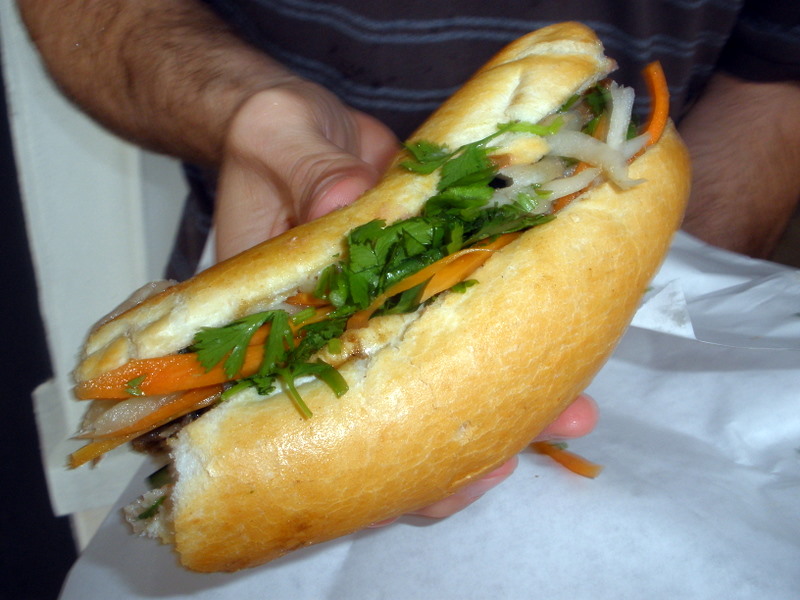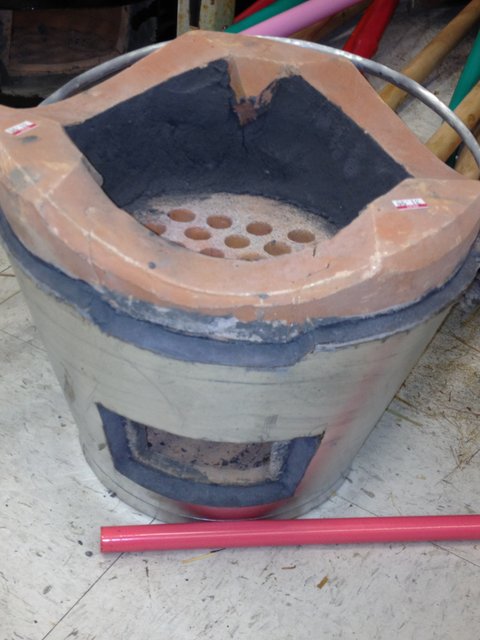
HungryC
-
Posts
1,502 -
Joined
-
Last visited
Content Type
Profiles
Forums
Store
Help Articles
Posts posted by HungryC
-
-
Here's another southeast Louisiana Vietnamese poboy....can't remember the source, but it's fairly representative of the local ingredient-to-bread ratio and overall size of loaf. It had a thit nuong (grilled pork) filling.

-
I repeatedly return to "Biscotti", a cookie book published by the American Academy in Rome. It contains a variety of biscotti, nut cookies, and other very Italian cookies (in other words, not too sweet and on the small side). The cantucci di Prato recipe is perfect, and the hazelnut tozetti are my favorite.
http://www.amazon.com/Biscotti-Recipes-Kitchen-American-Sustainable/dp/1892145898
-
Wow, thanks for the ref to your favorite 'BM' spot.
I wonder what the 'standard' BM is : it has in my area pate/aioli/ then a mysterious 'head cheese' like item then etc etc
can anyone enlighten me on what the 'head cheese' like item is?
many thanks!
Your "headcheese" might be pork roll (Cha lua or gio lua)....does it look like this: http://en.wikipedia.org/wiki/Gi%C3%B2_l%E1%BB%A5a
-
Char siu (Xa xiu in vietnamese) is a standard filling for bahn mi at my favorite BM joint, which happens to be a bakery suppling rolls to most of the Viet restaurants around the area (as well as to white-tablecloth places). Here is the BM menu from Dong Phuong, where you can buy 10 sandwiches and get one free: http://www.dpbanhmi....ry/Banh_Mi.html
I usually go for the #1 Dac Biet (house special), which is overflowing with housemade rolled ham, pate, and other porky goodness.
I have tried, many times, with NO success, to make a BM roll as light & airy as what I can purchase at many Viet bakeries in SE Louisiana. I think that the feathery light rolls have some dough conditioners and require a steam-injected oven to get the "right" texture. I can attest that rice flour does nothing for the texture.
When making 'em at home, I usually fill with ga nuong (grilled boneless chix thighs), and I use Andrea Nguyen's recipe (lime juice, fish sauce, a little sugar, black pepper, and oil). Or, I buy red-cooked boneless pork from the asian supermarket & use it (pictured below).

-
 1
1
-
-
I don't have a DigIQ or any fancy controllers, and I find it pretty damn easy to achieve 250 for 8-12 hours with no adjustments. As for aftermarket accessories, I have a plate setter (which is a big ceramic heat shield), a cooking grid riser that doubles as a wok stand, and a couple of pizza stones (full round and 1/2 moon). Of course, some gadget freaks have an endless array of specially crafted grids, stackers, rib stands, etc.
-
Gratuitous food pic of pork loin cooking on my mini....

-
I own two, a large and a mini. The cooker won't make your food magically better, and it's certainly no substitute for good grilling & smoking skills. Still, I don't regret a penny of the (substantial) price, mainly because of the versatility. I use it as a wok stove, to bake bread when I don't want to heat up the kitchen, to do sub-5 minute pizzas, for low & slow smoking, and all the usual grill tasks. I can attest that it does hold heat and a steady temp amazingly well. Check out the non-company sponsored fan forum at greeneggers.net.....friendly people who will answer your questions, provide cooking support, and happily share their considerable knowledge.
The few people I've known who were disappointed in the egg lacked fundamental outdoor cooking skills and also lacked patience. It's not an idiot-proof device: you do have to learn how to use it and understand basic principles of airflow, firestarting, and cooking. Again, the forum folks are more than happy to help people thru the brief initial learning curve.
-
I can see the crackers working, but I can't wrap my head around a completely flour-free puff pastry. Do post your results, please.
-
Consider the nut limitation a challenge rather than an obstacle....think about the cookie's texture. Tuiles, madelines, biscotti, meringues: you can vary flavors & textures with different styles of cookies, rather than focusing on a drop-style cookie dough embellished with chunky things. When I need cookie inspiration, I usually turn to Alice Medrich's Chewy Gooey Crispy Crunchy. She organizes the book according to texture, and each recipe is loaded with variations.
Avoid bland cookies by flavoring the sugar with herbs (mint, rosemary, lavender) or citrus zest (whether crushing together by hand or by food processor).
-
I think I'd opt for the heavy-duty stainless steel version (about $25) of the paint mixer attachment.....dunno if the plastic version is food safe.
-
I live in the land of bread pudding, where it appears on damn near every menu, from cafeterias & greasy spoons to gastronomic temples. You could try what's called "ghetto" bread pudding (sorry if I offend, I'm simply describing a common local useage): a can of fruit cocktail mixed into it before baking. If this is too downmarket for your sensibilities, try rehydrated, chopped dried cherries or currants.
But you should make your life even easier and just beat ingredients (except for the bread) together & not bother with cooking into a custard first. It will set into custard just fine while baking, though it might take a tad bit longer.
Another common variant is to substitute sweetened condensed milk for the sugar.
I like mixing a little stale cake, muffins, or sweet bread with plain bread--stale gingerbread is an especially tasty addition.
-
Not news to Gulf Coast dwellers...live Louisiana crabs have been trucked to the Chesapeake area for decades; our picked crabmeat is shipped all over the country. S'okay, Gulf crabs are every bit as good as Chesapeake, and are the exact same species (Callinectes sapidus rathbun). I avoid the imported, pasteurized stuff, but LA/TX/MS/AL crabs are fine by me.
I always thought of "Maryland crabcakes" as a style indicator, rather than an indicator of provenance. You occasionally see "Maryland style crabcakes" on menus in Louisiana....
-
Are spiced nuts too messy? Roast pecans, walnuts, or almonds w/butter and a blend of spices that will complement your dinner, setting the tone for the flavors to come.
-
The world is full of spores. Not a pleasant thought, but true. The stuff growing on veg is of minimal ability to infect people so no worry there.
Absolutely true. Mold spores are pervasive...you will not prevent future moldy fruit through cleaning. The mold spores are already on the fruit's skin while it is hanging on the tree. Conditions must be right for the mold to multiply--don't store citrus (or any fruit/veg, really) in a plastic bag or container. They're technically still respiring, and moisture will build up inside the plastic and create mold-friendly conditions. No matter how clean your kitchen is (or isn't), mold will still form when conditions are favorable.
-
Kim - where did you get your seeds? I found this place: evergreenseeds.com - it's a Yahoo store (temporarily closed until June 20th) but I don't know if there's somewhere better out there...
For herb seeds, try Baker Creek Heirloom seeds...a huge variety of basils, lots of other Asian-cooking herbs (shiso, etc). See the basils here: http://rareseeds.com/catalogsearch/result/?q=+basil&searchbox=products&Submit=
-
Chicken salad, egg salad, deviled eggs, omelets, vinagrettes, potato salad: any savory dish where you might use parsley or mint.
-
Remember to store rice and grains in GLASS jars with Oxygen Absorbers and Silica Paks in them (check Amazon)
And Instant Noodles dont keep very long, the oil they are fried in can turn them rancid
I wouldn't keep the emergency supplies on hand for more than 6-8 months--the idea is to use 'em up and buy fresh next H-season. (I'm not preparing for earthquakes or other year round disaster potential). Truly, my emergency preparedness involves drawing down the frozen food supplies in the appropriate season so that a lengthy power interruption doesn't lead to huge food losses, rather than stockpiling. After a tropical weather event, we often eat well as everything frozen begins to thaw.
-
Canned tuna is great in a survival kit, as it is a food acceptable to most people when served at room temperature. Try the pouches or poptop cans rather than the cans requiring an opener. My hurricane supplies include canned beans, applesauce/fruit cups, canned fruit juices (hey, you might need some mixers for the vodka or gin that is most certainly part of your survival kit), instant coffee, dried milk powder (mostly for the instant coffee), tea bags, instant noodles, and beef jerky. Experience has proven that a hot cup of coffee can make post-disaster cleanup mornings bearable.
As for cooking, I always have on hand propane and charcoal...I just fill up all the cylinders & buy a couple extra bags of lump during H-season...which started last Friday. As for water, I fill up foodsafe containers & stick 'em in the chest freezer...they serve the dual purpose of extending the freezer's unplugged-yet-still-frozen time window as well as providing drinking water when needed.
-
I have some mulato chiles...can anyone suggest a good use of mulatos? TIA
-
I like this sweet potato & roasted poblano pepper salad from Epicurious: http://www.epicurious.com/recipes/food/views/Sweet-Potato-and-Poblano-Salad-with-Honey-and-Rosemary-353851
-
Thanks for all the suggestions everyone. Some very good insight.
Some possibilities I have thought of and that have been inspired by the discussion here:
- predominately cooking proteins sous vide
Please investigate your local health department's regulations & requirements regarding sous vide. NYC requires an extremely detailed hazard analysis & critical control point plan before any food outlet can do vaccuum-sealed cooking.
-
For about $30 (or roughly double the price of a metal chimney starter), you might find a terracotta and metal wok stove at your local asian market. My local market has them in two sizes, one in a small metal pail and the other in a slightly larger metal tub. See pics...


-
Wow--those look so tasty! Glad you liked the recipe; Andrea's website & cookbooks are great resources.
-
I have lived my entire life in Louisiana's sugar producing region. Refrigerated, fresh cane will last a week or so...it sours fairly quickly, but a sniff will tell you when it's going off/beginning to ferment. Sure you can chew it (and the spitting is part of the fun), but split lengthwise into batons, it can be used as a flavorful skewer for grilled meats or seafood. A typical Vietnamese dish, chao tom, involves seasoned shrimp paste formed around cane slivers...here's Andrea Nguyen's recipe.
Have also seen chunks of it boiled in water used to make lightly flavored/sweetened iced tea, as well as chunks in asian soups (though you need to tell unfamiliar diners not to eat it, but to chew & discard).

Cook-Off 60: Banh Mi
in Cooking
Posted
Well, I thought that people without ready access to BMs might like to see what passes for "standard" in order to concoct their own riffs! I'm just happy to live in a place where I can get freshly baked banh mi loaves at 4 for $1.00.